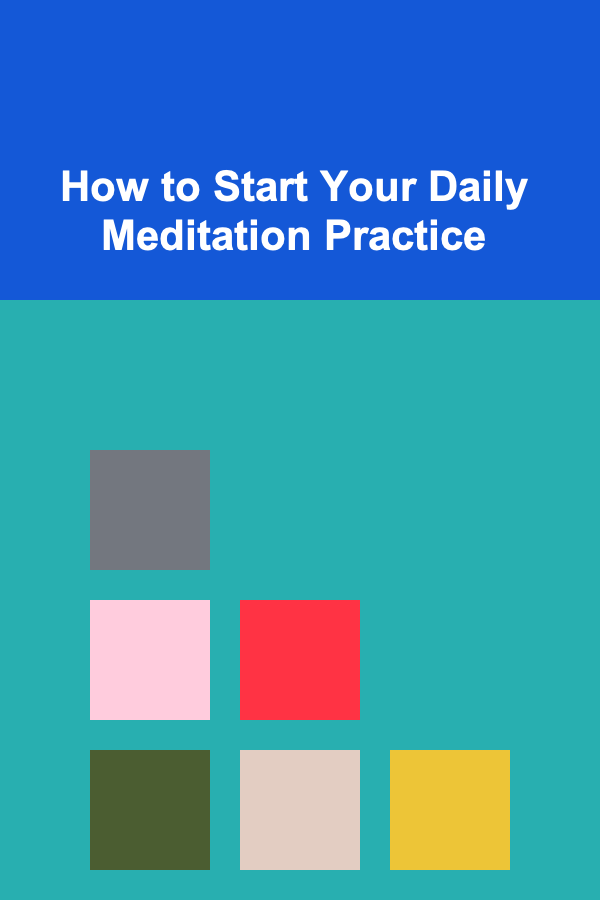
How to Start Your Daily Meditation Practice
ebook include PDF & Audio bundle (Micro Guide)
$12.99$9.99
Limited Time Offer! Order within the next:

Meditation is a practice that has been used for thousands of years across various cultures and traditions. From its ancient roots in Eastern spiritual practices to its widespread use in the modern world for health and well-being, meditation has proven to be a powerful tool for reducing stress, increasing focus, and fostering inner peace. If you're looking to start your daily meditation practice, this guide will take you through the essential steps, tips, and techniques to help you get started.
Understanding Meditation
Meditation is a process of focusing the mind, training it to stay in the present moment, and cultivating a sense of mindfulness. It involves setting aside time to reflect, relax, and allow the mind to become still. There are various forms of meditation, ranging from mindfulness and concentration practices to loving-kindness and transcendental meditation.
The ultimate goal of meditation is to help you develop greater awareness and control over your thoughts, emotions, and actions. This allows you to live more consciously and mindfully, which can lead to greater inner peace, better emotional regulation, and improved overall well-being.
The Benefits of Daily Meditation
Before diving into the how-to aspect of starting a daily meditation practice, it's important to understand why you should meditate. There are countless benefits to meditation, both physical and psychological. Some of the key benefits include:
- Reduced Stress and Anxiety: Meditation helps calm the mind and promotes relaxation. It has been shown to lower levels of cortisol (the stress hormone) and reduce feelings of anxiety.
- Improved Focus and Concentration: Regular meditation strengthens the brain's ability to concentrate and pay attention, improving cognitive function and mental clarity.
- Better Emotional Regulation: Meditation allows you to become more aware of your emotions, helping you manage them in healthier ways.
- Enhanced Self-Awareness: Meditation encourages introspection and self-reflection, leading to a deeper understanding of oneself and one's patterns of thinking.
- Improved Physical Health: Regular meditation has been shown to reduce blood pressure, improve sleep, and strengthen the immune system.
- Increased Mindfulness: Meditation cultivates mindfulness, which is the ability to stay present and aware of your thoughts, feelings, and surroundings.
Getting Started with Meditation
Starting a daily meditation practice can feel intimidating, especially if you've never meditated before. But the good news is that meditation is simple, and with just a few minutes each day, you can begin to experience its many benefits. Here's how to get started:
1. Set a Clear Intention
The first step in starting a meditation practice is to set a clear intention. Why do you want to meditate? What do you hope to achieve from this practice? Your intention could be anything from reducing stress to improving concentration or simply finding a moment of peace in your day.
Having a clear intention will help you stay motivated and committed to your practice, especially during the initial stages when it might feel challenging.
2. Create a Comfortable Space
A key element to successful meditation is creating a comfortable and peaceful environment. While you can meditate anywhere, it's helpful to choose a quiet space where you can relax and focus without distractions.
Your meditation space should be free from noise, clutter, or anything that might distract you. You can create a calming atmosphere by dimming the lights, lighting candles or incense, or playing soothing music if that helps you relax.
Consider using a cushion or chair to sit on, or lie down if that's more comfortable. The goal is to find a position that allows you to be relaxed but also alert.
3. Choose a Time
Consistency is crucial when establishing a meditation practice. To form the habit, it's helpful to meditate at the same time every day. Whether it's first thing in the morning, during your lunch break, or before bed, find a time that works for you and commit to it.
Many people find it beneficial to meditate in the morning, as it sets the tone for the rest of the day. However, the best time for meditation is when you can be consistent, focused, and undistracted.
4. Start with Short Sessions
If you're new to meditation, start with short sessions. Five to ten minutes is a great starting point. The key is not to force yourself to meditate for long periods, especially in the beginning. Starting with short sessions allows you to build the habit without feeling overwhelmed.
As you get more comfortable with the practice, you can gradually increase the length of your sessions. The most important thing is to stay consistent.
5. Focus on Your Breath
One of the simplest and most common forms of meditation is breath-focused meditation. To meditate, sit or lie comfortably, close your eyes, and begin to focus on your breath.
- Inhale deeply through your nose, allowing your belly to expand.
- Exhale slowly through your mouth or nose, letting go of tension.
- Pay attention to the sensation of the breath as it enters and leaves your body.
If your mind begins to wander (which it will!), gently guide your attention back to your breath. Don't be hard on yourself if you lose focus; simply acknowledge the thought and return to your breathing.
6. Be Gentle with Your Mind
Meditation is not about forcing your mind to be empty or still; it's about observing your thoughts without judgment. It's natural for thoughts to arise, and part of the practice is simply noticing them and letting them go.
If you find that your mind is particularly active during meditation, try to gently redirect your focus back to your breath or another point of focus. You can also try repeating a mantra or affirmation to help anchor your thoughts.
7. Experiment with Different Meditation Techniques
There are various types of meditation techniques, and it's important to explore different ones to find what works best for you. Here are a few popular techniques you can try:
- Mindfulness Meditation: This involves paying attention to your breath, thoughts, and physical sensations in the present moment without judgment.
- Loving-Kindness Meditation: In this practice, you focus on sending well-wishes and compassion to yourself and others.
- Body Scan Meditation: This involves focusing on each part of your body, from head to toe, to release tension and become more aware of physical sensations.
- Guided Meditation: A guided meditation involves following the instructions of a teacher or audio recording. This can be helpful for beginners.
- Mantra Meditation: This involves repeating a word, sound, or phrase (a mantra) to focus the mind.
You can experiment with these different techniques to find which one resonates with you the most. The key is to stay consistent and patient, as it may take some time to find the meditation style that feels most natural.
8. Cultivate Patience and Consistency
Meditation is a practice, which means it takes time and consistency to experience its full benefits. Don't be discouraged if you don't notice immediate results or if your mind is particularly restless at times. It's normal to encounter obstacles along the way.
The most important aspect of meditation is showing up every day, even if just for a few minutes. Over time, your practice will deepen, and you'll begin to notice the positive changes in your mind and body.
9. Reflect on Your Practice
After each meditation session, take a few moments to reflect on how you feel. Do you feel more relaxed? More focused? Do you notice any changes in your thoughts or emotions?
Journaling can be a helpful tool for this reflection. Writing down your thoughts can help you track your progress, identify patterns, and stay motivated.
10. Stay Open-Minded
It's important to stay open-minded when starting a meditation practice. Meditation is deeply personal, and there is no "right" or "wrong" way to meditate. Allow yourself to explore different techniques and find what works for you.
As you continue your practice, you may notice changes in your life that extend beyond the meditation cushion. You may feel more grounded, less reactive, or more connected to your inner self. These changes will become clearer as you meditate regularly.
Overcoming Common Challenges in Meditation
While meditation can be deeply rewarding, it's not without its challenges. Some common obstacles that beginners face include:
- Restless Thoughts: It's normal to experience a busy mind, especially when starting out. The key is to gently return your focus to your breath or chosen meditation technique.
- Discomfort: Sitting for extended periods can be uncomfortable. Make sure to find a position that works for you, and use cushions or chairs if needed.
- Time Constraints: If you struggle to find time to meditate, start with short sessions and gradually build your practice as your schedule allows.
- Frustration or Impatience: Meditation is a practice, and progress may be slow at first. Be patient and kind with yourself.
Remember, meditation is not about achieving perfection; it's about cultivating a regular practice that helps you become more present and aware in your daily life.
Conclusion
Starting a daily meditation practice is a powerful step toward improving your mental and physical well-being. By following the steps outlined in this guide, you can create a practice that suits your needs and lifestyle. Whether you meditate for 5 minutes or 30 minutes, the key is to remain consistent and patient with yourself. As you deepen your practice, you'll begin to notice the profound benefits of meditation, including reduced stress, better focus, and greater emotional resilience. Enjoy the journey of self-discovery and mindfulness that meditation offers.

How to Choose the Right Investment Accounts for Your Goals
Read More
How to Clean Your Home Without Breaking Your Budget
Read More
How to Organize Your Bath Products for a Streamlined Routine
Read More
How to Price Your Health and Nutrition Consulting Services
Read More
How to Use Online Advertising to Boost Sales of US Goods Overseas
Read More
How to Price Your Graphic Design Services -- A Comprehensive Guide
Read MoreOther Products

How to Choose the Right Investment Accounts for Your Goals
Read More
How to Clean Your Home Without Breaking Your Budget
Read More
How to Organize Your Bath Products for a Streamlined Routine
Read More
How to Price Your Health and Nutrition Consulting Services
Read More
How to Use Online Advertising to Boost Sales of US Goods Overseas
Read More